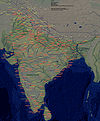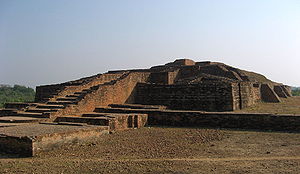
Sravasti
Encyclopedia

India
India , officially the Republic of India , is a country in South Asia. It is the seventh-largest country by geographical area, the second-most populous country with over 1.2 billion people, and the most populous democracy in the world...
, was one of the six largest cities in India during Gautama Buddha
Gautama Buddha
Siddhārtha Gautama was a spiritual teacher from the Indian subcontinent, on whose teachings Buddhism was founded. In most Buddhist traditions, he is regarded as the Supreme Buddha Siddhārtha Gautama (Sanskrit: सिद्धार्थ गौतम; Pali: Siddhattha Gotama) was a spiritual teacher from the Indian...
's lifetime. The city was located in the fertile Gangetic plains in the present day Gonda
Gonda District
Gonda is one of the districts of Uttar Pradesh, India. Gonda is the district headquarters, and also the administrative centre for the Devipatan Division....
District of Uttar Pradesh
Uttar Pradesh
Uttar Pradesh abbreviation U.P. , is a state located in the northern part of India. With a population of over 200 million people, it is India's most populous state, as well as the world's most populous sub-national entity...
near Balrampur
Balrampur
Balrampur is a city and a municipal board in Balrampur district in the state of Uttar Pradesh, India. It is situated on the bank of river Rapti and is the district headquarters of Balarampur district...
some 120 km north of Lucknow. Jetavana
Jetavana
Jetavana was one of the most famous of the Buddhist monasteries in India. It was the second monastery donated to Gautama Buddha, after the Veluvana in Rajagaha. Jetavana is located just outside the old city of Savatthi...
monastery was a famous monastery close to Savatthi.
Origin of Sravasti

Mahabharata
The Mahabharata is one of the two major Sanskrit epics of ancient India and Nepal, the other being the Ramayana. The epic is part of itihasa....
, the origin of Sravasti lies with the legendary king Shravasta. According to Buddhist tradition,
the city was called Savatthi because the sage Savattha lived there. Another tradition says there was a caravanserai
Caravanserai
A caravanserai, or khan, also known as caravansary, caravansera, or caravansara in English was a roadside inn where travelers could rest and recover from the day's journey...
there, and people meeting there asked each other what they had ("Kim bhandam atthi?"), then replied "Sabbam atthi" (meaning "we have all things", as in everything).
Sravasti in the Buddha's time
Savatthi was located on the banks of the river AciravatiAciravati
The Acirvati was an ancient river flowing through what is now Nepal and the northern portion of Uttar Pradesh. It has been identified with the modern Rapti....
(now called the Rapti
West Rapti River
Not to be confused with the East Rapti in Chitwan Valley some to the east, this Rapti drains Rapti Zone in Mid-Western Region, Nepal, then Awadh and Purvanchal regions of Uttar Pradesh state, India before joining the Ghaghara a major left bank tributary of the Ganges.The West Rapti is notable for...
river). It was the capital city of the kingdom of Kosala, and its king was called Pasenadi
Pasenadi
Pasenadi was a dynasty ruler of Kosala. He succeeded his father . He was a prominent of Gautama Buddha, who built many Buddhist monasteries.-Life:...
, who was a disciple of Buddha. It is a beautiful city with vast amounts of agriculture and diversity. Buddhaghosa
Buddhaghosa
Bhadantācariya Buddhaghoṣa(Chinese: 覺音)was a 5th-century Indian Theravadin Buddhist commentator and scholar. His best-known work is the Visuddhimagga, or Path of Purification, a comprehensive summary and analysis of the Theravada understanding of the Buddha's path to liberation...
says that, in the Buddha's day, there were fifty seven thousand families in Savatthi, and that it was the chief city in the country of Kasi Kosala
Kosala
Kosala was an ancient Indian region, corresponding roughly in area with the region of Awadh in present day Uttar Pradesh. According to the Buddhist text Anguttara Nikaya and the Jaina text, the Bhagavati Sutra, Kosala was one of the Solasa Mahajanapadas in 6th century BCE and its cultural and...
, which was three hundred leagues in extent and had eighty thousand villages. He stated the population of Sávatthi to have been 180 million. The road from Rajagaha to Savatthi passed through Vesali, and the Parayanavagga gives as the resting places between the two cities: Setavya, Kapilavatthu, Kusinara, Pava
Pava
thumb|right|325px|A stupa built at the place where Cunda's house used to be, at the site of ancient Pava.Pava was a city in ancient India, at the time of Gautama Buddha. It was a city of the Mallas which the Buddha visited during his last journey, going there from Bhogagama and staying at Cunda's...
and Bhoganagara. Further on, there was a road running southwards from Savatthi through Saketa to Kosambi
Kosambi
Kosambi may refer to:*Kosambi, India, an old city and Buddhist pilgrimage site.*Kosambi, Tangerang, a subdistrict of Tangerang Regency, Banten, Indonesia*Kosambi, Jakarta, an administrative village of Cengkareng, West Jakarta, Indonesia...
. Between Saketa and Savatthi was located Toranavatthu.
The Buddha passed the greater part of his monastic life in Savatthi. His first visit to Savatthi was at the invitation of Anathapindika, whom he met in Rajagaha. The main monasteries in Sravasti were the Jetavana and the Pubbarama. Savatthi also contained the monastery of Rajakarama, built by Pasenadi, opposite Jetavana. Not far from the city was a dark forest called the Andhavana, where some monks and nun went to live. Outside the city gate of Savatthi was a fisherman's village of five hundred families.

Anathapindika
Anathapindika was the chief lay disciple of Gautama Buddha. His given name was Sudatta. He was extremely wealthy and a patron of the Buddha. He gave Jeta Park to the Buddha having purchased it from Prince Jeta. He honored the Buddha with laying out 1.8 million gold pieces in the grove...
, Visakha
Visakha
Viśākhā, also referred to as Migara's mother , was one of the chief female lay disciples of the Buddha. She became a stream-enterer and died at the age of 120....
, Suppavasa and Pasenadi
Pasenadi
Pasenadi was a dynasty ruler of Kosala. He succeeded his father . He was a prominent of Gautama Buddha, who built many Buddhist monasteries.-Life:...
. When Bandhula left Vesali he came to live in Savatthi.
Woodward states that, of the four Nikaya
Nikaya
Nikāya is a word of meaning "collection", "assemblage", "class" or "group" in both Pāḷi and Sanskrit. It is most commonly used in reference to the Buddhist texts of the Sutta Piṭaka, but can also refer to the monastic divisions of Theravāda Buddhism...
s, 871 suttas are said to have been preached in Savatthi; 844 of which are in Jetavana
Jetavana
Jetavana was one of the most famous of the Buddhist monasteries in India. It was the second monastery donated to Gautama Buddha, after the Veluvana in Rajagaha. Jetavana is located just outside the old city of Savatthi...
, 23 in the Pubbarama, and 4 in the suburbs of Savatthi. These suttas are made up of 6 in the Digha Nikaya
Digha Nikaya
The Digha Nikaya is a Buddhist scripture, the first of the five nikayas, or collections, in the Sutta Pitaka, which is one of the "three baskets" that compose the Pali Tipitaka of Theravada Buddhism...
, 75 in the Majjhima Nikaya
Majjhima Nikaya
The Majjhima Nikaya is a Buddhist scripture, the second of the five nikayas, or collections, in the Sutta Pitaka, which is one of the "three baskets" that compose the Pali Tipitaka of Theravada Buddhism...
, 736 in the Samyutta Nikaya
Samyutta Nikaya
The Samyutta Nikaya is a Buddhist scripture, the third of the five nikayas, or collections, in the Sutta Pitaka, which is one of the "three baskets" that compose the Pali Tipitaka of Theravada Buddhism. Because of the abbreviated way parts of the text are written, the total number of suttas is...
, and 54 in the Anguttara Nikaya
Anguttara Nikaya
The Anguttara Nikaya is a Buddhist scripture, the fourth of the five nikayas, or collections, in the Sutta Pitaka, which is one of the "three baskets" that comprise the Pali Tipitaka of Theravada Buddhism...
. The Commentaries state that the Buddha spent twenty five rainy seasons in Sávatthi, thus leaving only twenty to be spent elsewhere. Of the 25 rainy seasons Buddha lived in Sravasti, he spent 19 in the monastery named Jetavana
Jetavana
Jetavana was one of the most famous of the Buddhist monasteries in India. It was the second monastery donated to Gautama Buddha, after the Veluvana in Rajagaha. Jetavana is located just outside the old city of Savatthi...
, and 6 in the monastery called Pubbarama. Thus, Sravasti is the place where Buddha lived the longest amount of time, and it is the place where he gave the largest amount of discourses and instructions.
The Chinese Pilgrim Xuanzang
Xuanzang
Xuanzang was a famous Chinese Buddhist monk, scholar, traveler, and translator who described the interaction between China and India in the early Tang period...
found the old city in ruins, but recorded the sites of various buildings.
Current Sravasti
Of the ancient Savatthi the city walls are still standing. Within these, the remains of 3 ancient buildings can be visited: AngulimalaAngulimala
Daku Angulimala is an important early figure in Buddhism, particularly within the Theravada suttas...
's stupa, Anathapindika
Anathapindika
Anathapindika was the chief lay disciple of Gautama Buddha. His given name was Sudatta. He was extremely wealthy and a patron of the Buddha. He gave Jeta Park to the Buddha having purchased it from Prince Jeta. He honored the Buddha with laying out 1.8 million gold pieces in the grove...
's stupa, and an old temple dedicated to a Jain Tirthankara. Outside of Savatthi is located the stupa where the Twin Miracle (Pali
Páli
- External links :* *...
:Yamaka Patihara) took place. The site of Jetavana monastery is the main pilgrim
Pilgrim
A pilgrim is a traveler who is on a journey to a holy place. Typically, this is a physical journeying to some place of special significance to the adherent of a particular religious belief system...
destination, with meditation
Meditation
Meditation is any form of a family of practices in which practitioners train their minds or self-induce a mode of consciousness to realize some benefit....
and chanting mainly done at the Gandhakuti (Buddha's hut) and the Anandabodhi tree. Buddhist monasteries from the following countries have been constructed at Sravasti: Thailand, South Korea, Sri Lanka, Myanmar, Tibet and China.

